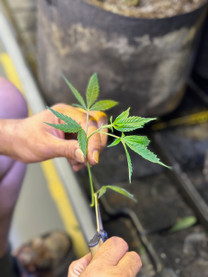4th Apr 2024
Emerald Heart's Guide to Cloning 101
Have you ever cloned a plant before? Most plants are actually pretty easy (and free) to propagate by cloning!
Cloning is the process of taking part of a healthy plant, replanting it, and having it grow. Since this is a form of asexual reproduction, there is only one set of DNA, so this new plant will be genetically identical to the one it was cut from. For growing hemp specifically, cloning can be helpful to ensure compliance with strict industry regulations.
How old should a plant be before taking clones?
Successful clones are usually cut from a plant during its vegetative growth, before the flowering phase. Ideally, the plant will be at least 5 weeks old from its seedling stage, and have several side shoots of growth to cut from. Any plant can be cloned, but cuttings root the quickest when taken from a plant in a vegetative growth stage, before they are fruiting and/or flowering.

What part of the plant do I cut from?
Cloning is easiest when cut from the tip of the plant's stem. However, you can cut multiple clones by cutting from the middle or bottom of the stem. You only need about 2-4 inches of growth to make a cutting.
Pro tip: Make your cutting at a 45 degree angle to increase surface area for potential root sites and encourage the plant to send energy to its roots instead of focusing on growing leaves.
Do cuttings root better in water or soil?
Some plants will root in water, but we have personally seen the most consistent success with placing clones in a soil-less potting mix to root. We prefer Promix HP (available for purchase in our store location) for its high quality drainage. Clones can die from too much or too little water.

Do I need rooting hormones?
Rooting hormones like Clonex or natural agents like aloe vera gel are not necessary, but can help speed up the rooting process.
What if my cuttings fail to root?
Cuttings are very delicate, and it is not uncommon to lose a couple of cuttings from every batch. Fresh cuttings require much more humidity than seedlings, and humidity domes are essential for ensuring the roots have enough moisture to grow. A heating pad below the cloning tray can also be beneficial to encourage root growth. Once you notice that the clone is growing, the dome can be removed to let air circulate and to prevent mold. This is also a fine time to transplant the cutting into its permanent container or into the ground.

We hope this guide inspires you to try cloning a plant for yourself! You can practice by cutting the stem of a houseplant and placing it in water to watch the roots grow. This is a great way to learn (and get free houseplants). ;-)

